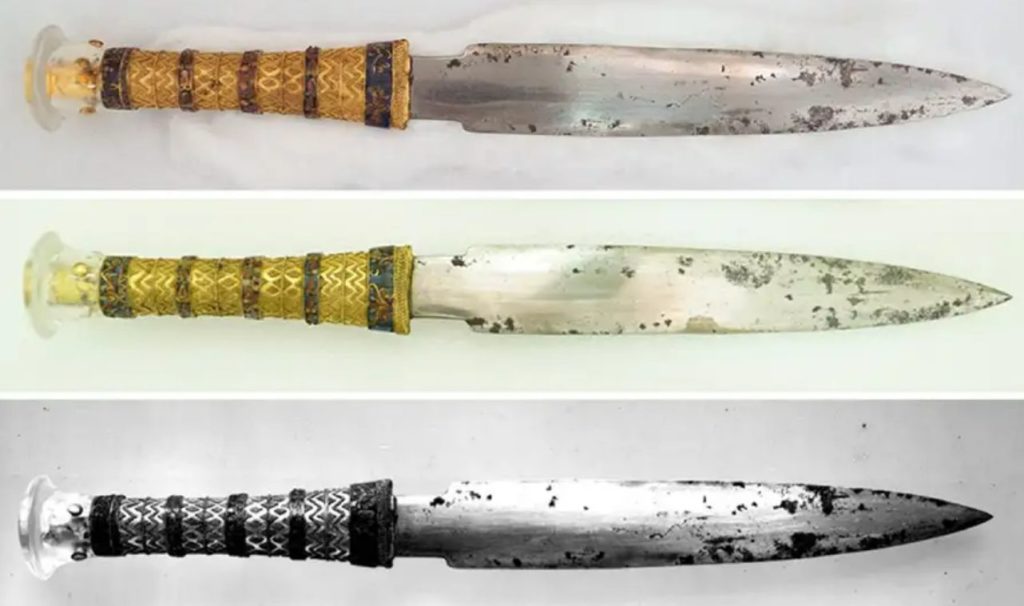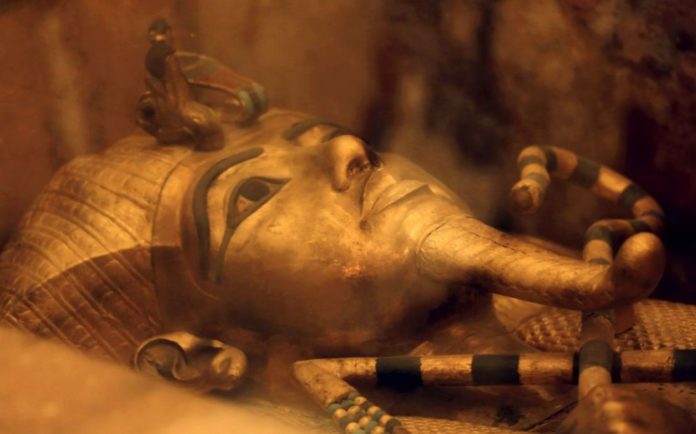Researchers believe that it was not made in Egypt.
An iron dagger discovered in Tutankhamun’s tomb was recently X-ray scanned to determine how the weapon, whose metal came from a meteorite, was produced. The team believes the dagger was forged at a low temperature, but they don’t believe it was made in Egypt.
In the 1920s, investigators discovered a foot-long dagger in Tutankhamun’s burial chamber in the Valley of the Kings, among the splendor entombed with the king. Its blade was constructed of iron, which is surprising given that the Iron Age didn’t begin until a century after Tut’s death.
Researchers believe that ancient iron artefacts, which predate extensive knowledge of iron metallurgy, are made of meteoritic iron—metal bits that fell from the sky and were then forged on Earth.
It was especially valued in Egypt and elsewhere. Tutankhamun was born 1,000 years before a meteoritic knife was discovered in Turkey dating from the Early Bronze Age. Tutankhamun was also buried with an iron headrest and an iron bracelet, in addition to the dagger.
The pharaoh’s iron was certainly meteoritic in origin, according to 2016 research, but concerns persisted regarding what kind of meteorite it originated from and how it was formed. That’s where the latest study, published in Meteoritics & Planetary Science this month, comes in.

“To understand the manufacture and origin of the dagger, we conducted on-site non-contact, non-destructive two-dimensional chemical analysis for the dagger,” Tomoko Arai, the study co-author, told Gizmodo.
By shining X-rays on the blade, the group was able to see where iron, nickel, manganese, and cobalt were concentrated. Sulfur, chlorine, calcium, and zinc were discovered in the blackened patches on the blade. The distribution of the elements was just as fascinating as the presence of the elements.
“We noticed a cross-hatched texture present in places for the both sides [of the dagger], suggesting Widmanstätten structure, typical of [an] octahedrite iron meteorite,” said Arai. “That was our WOW moment.”
The Widmanstätten pattern (named after an Austrian mineralogist) is a striking feature that occurs in some metallic meteorites and is generated by the distribution of nickel throughout the objects. Tutankhamun’s dagger has a pattern that shows it was produced from an octahedrite, the biggest type of iron meteorite.
The scientists compared the design on Tut’s dagger to the pattern on the Japanese meteorite Shirahagi to confirm what they were seeing in the elemental study. The iron in certain Japanese swords purchased by the Taisho Emperor came from Shirahagi. Octahedrites appear to be a favorite of kingdoms around the world.
The appearance of the pattern on the ancient Egyptian dagger also suggests how it was produced. The Widmanstätten pattern would vanish if the iron was heated to an extremely high temperature, according to the team’s report.
“We also found small black patches in places on the surface,” Arai added. “We thought they were rust at first. But it turns out that they were iron sulfide, which generally occurs as inclusions in octahedrite iron meteorites.”
Iron sulfide, as well as the faint Widmanstätten pattern, show that the dagger was made at a low temperature. It was made at less than 950° Celsius (1,742° Fahrenheit), according to Arai.
The scientists resorted to a set of 3,400-year-old tablets known as the Amarna Letters, which describe diplomatic actions in ancient Egypt in the mid-14th century BCE, when the chemical analysis failed to reveal the dagger’s origins. When Tutankhamun’s grandfather, Amenhotep III, married his daughter, the king of Mitanni, a region of Anatolia, presented him with an iron dagger in a gold sheath—presumably not a typical item at the time.
So Tutankhamun’s space dagger could have been a family heirloom brought back from Egypt. The gemstones in the dagger’s hilt were also connected with lime plaster, which was prevalent in Mitanni but didn’t catch on in Egypt until later, according to the researcher’s elemental study.
Future investigations, according to Arai, will help to corroborate this appraisal of the blade. This dagger’s narrative didn’t finish with its royal burial, whether it was an amazing wedding present or not.
Source: 10.1111/maps.12664 and 10.1111/maps.13787
Image Credit: AP
You were reading: Researchers reveal the mystery of Tutankhamun’s meteorite dagger: “WOW moment”
